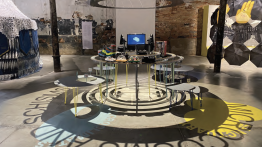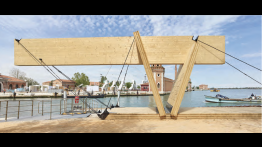Designs for Living
POSTED ON: December 13, 2021
For this year’s Architecture Venice Biennale, the 17th in the history of the event, the architect and curator Hakim Sarkis posed a question borne of our era of divisiveness: How will we live together? Architects and artists from The Cooper Union were among the 112 participants to respond to Sarkis’s query for the event, which opened on May 22 and runs until November 21.
Sarkis, dean of architecture at the Massachusetts Institute of Technology, sees growing income inequality, hardening political stances, and the dramatic impact of climate change as factors that design must address as a field predicated on collaboration both in the creation of space and in its use. Citing the needs for architects to work with builders and engineers as well as planners and politicians, Sarkis says that this year’s Biennale, which had been postponed by a year due to COVID-19, “asserts the vital role of the architect as both cordial convener and custodian of the spatial contract.”
One of the many Cooper teams to respond to Sarkis’ challenge included professors from The Irwin S. Chanin School of Architecture: Associate Dean Hayley Eber, a 2001 Cooper graduate, Lauren Kogod, Lydia Kallipoliti, Nora Akawi, and Ife Vanable. Their exhibition, entitled Microcosms & Schisms, examines interior and exterior spaces of New York City to discern how architecture is used both to segregate groups and to unify them. In crafting a response to “how we live together,” Eber said, the team needed to examine the notion of “we,” noting that the term “refers to a fictive entity and that any assumption of a unified ‘we’ is at best doubtful. We can become a provisional ‘we’ in some contexts and, in so many others, access is denied, the sense of place-and-kin withheld or cancelled, ‘otherness’ established and architecturally embodied.”
Their own “we” had been seriously altered as a result of the pandemic. “[It] created an interesting set of challenges for us in dealing with how to exhibit the work, but more so executing a very collaborative and physical installation with the team scattered across the globe,” said Eber. The group’s work was supported by grants from the IDC Foundation, which had originally been earmarked for travel, but instead covered installation material costs after the Biennale was delayed. They divided their analysis into four collectives led by the Cooper professors working with graduate students: spaces of sanctuary, deep segregation, parks, and microclimates. A model train that runs throughout their exhibition acted as a connective tissue among these four elements and signified the role of the subway in New York City during the public health crisis. “Each train line in many ways represented a world,” said Eber. “An immersive lived territory but also a space of imagination, of imagining other lifelines that were cohabiting the same city.”
During the pandemic, they noted, each of the four zones became further entrenched in their roles as spaces of isolation or immersion. Not surprisingly, the roles of race, gender, and class cut across all four zones; the notion of “sanctuary spaces,” for instance, conjures inherently class-based divisions, where for the wealthy it might mean a luxurious pied-a-terre apartment along the High Line while for poor and undocumented immigrants it means protection from the threat of forced confinement or deportation. Parks, in the team’s estimation, serve as the only true civic spaces, ones that during the pandemic transformed from an amenity to a necessity.
The late Diane Lewis AR’76, a renowned architect, author, and Cooper professor, may very well have agreed. She centered much of her teaching, writing, editing, and designing on the invaluable role of civic spaces in creating great cities, influencing scores of Cooper students via her fourth-year studio. Her outsized impact on architectural practice and theory was celebrated at this year’s Biennale with an exhibition entitled Conceiving the Plan curated by Yael Hameiri Sansaux AR’10 and Alessandro Melis, who succinctly describe Lewis’s core architectural belief: “For Diane Lewis the city was not only the result of a great number of historical, inextricable strata of form and memory. It was also greater than the sum of its individual architectures, and a mental universe all its own.” The two curators asked 12 architects, including Mersiha Veledar AR’03 of the Cooper architecture faculty, to exhibit proposals in keeping with Professor Lewis’ conceptual framework for analyzing cities.
According to Margaret Matz, a 1983 Cooper architecture graduate and former CUAA president who worked closely with Lewis, Venice, which this year celebrates the 1600th anniversary of its founding, is the appropriate setting for celebrating and revisiting the ideas advocated by Lewis, who saw the campi of the city as a stage for the Commedia dell’arte and, as Matz put it, its “emerging revolutionary public expression” that eventually migrated to Paris and influenced public discourse there. Matz and other architects have produced Venice Masked as a complementary exhibition toConceiving the Plan, a set of projects inspired by Lewis that propose ways to conceive of public space in Venice. Matz’s fellow curators for the project include Paola Barcarolo and Cooper alumni Frank Gerard Godlewski AR’82, Drew Knapp A’75, and Donato Giacalone AR’83 of Salam & Giacalone Architects PC.
In the Arsenale, the central exhibition space of the Biennale, Dean Nader Tehrani continues his experiments with Cross-Laminated Timber (CLT) with a portico at the hall’s terminus and a housing prototype within. This last is part of a project Tehrani’s firm NADAAA calls Other Ways of Living Together and considers ways that existing environments—urban, rural, and suburban—may be re-viewed via material and new interpretations of zoning laws to create living spaces more in line with what the firm calls this “moment of reckoning in relation to current environmental and social challenges.” NADAAA’s work can also be seen in Future Assembly, a curatorial initiative meant to respond to Sarkis’ request that architects “imagine a design inspired by the United Nations—the current paradigm for a multilateral assembly.” Tehrani and company presented an animation of the Zayandehrud River Basin in central west Iran, an area that had been dammed in 1971. The animation combines aerial views of Isfahan, just to the north of the river basin, and a planimetric scan. As the capital of Persia under Safavid rule (1501-1736), Isfahan was renowned as a city of canals,waterways that dried after the damming of the Zayandehrud and caused severe drought in some parts of the river’s watershed. (Haunting photos show bridges spanning desiccated riverbeds.) Tehrani’s animation reveals what the city had been before the river was dammed and the ways that the urban fabric had been predicated on the existence of water.
Professor David Gersten, who graduated from Cooper in 1991, has brought an exhibition entitled SunShip: The Arc that Makes the Flood Possible to Venice this year. The project is part of a collective he and others founded ten years ago, Arts Letters & Numbers. The group is dedicated to gathering thinkers from many disciplines—what Gersten calls a “giant diversity of voices”—to bring innovative, diverse ideas to discussions about complex problems. No matter what the subject, the group, according to Gersten, is “running after what we don’t know.”
Many more Cooper alumni and faculty make an appearance in this year’s Biennale. Peggy Deamer AR’77 is an exhibitor in Platform Austria, on view in the Austrian Pavilion. Jesse Reiser AR’81 and Nanako Umemoto’s AR’83 firm Reiser+Umemoto is bringing Geoscope 2, a panoramic multimedia experience, to the Biennale. In the virtual Italian Pavilion, visitors can find work by Michael Morris AR’89 whose firm SEArch+/Space Exploration Architecture designed Lunar Lantern. As part of the University of Pennsylvania’s Weitzman School of Design, Dorit Aviv AR’09, an assistant professor and director of the Thermal Architecture Lab at Penn, is presenting work on the fragility of the planets ecosystems. School of Art Adjunct Instructor João Enxuto and his collaborator, Erica Love are showing their work 2038—The New Serenity in the German Pavilion. Natalie Savva AR’13 is among the contributors to Anachoresis Upon Inhabit Distances on view in the Cyprus Pavilion. John Lin AR’02 and his firm Rural Urban Framework is presenting an installation that investigates Chinese exurbs. Elena Fanna AR’03 is part of the 2021 ECC Architecture Biennale at the European Culture Center in Venice with her project Time Stills.






